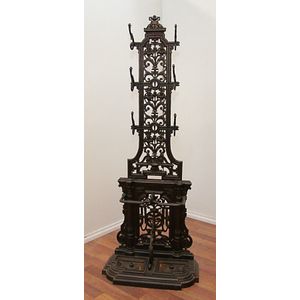Antique French Figural Spelter Clock with Key & Pendulum
You must be a subscriber, and be logged in to view price and dealer details.
Subscribe Now to view actual auction price for this item
When you subscribe, you have the option of setting the currency in which to display prices to $Au, $US, $NZ or Stg.
- Spelter - Spelter was the name given to an alloy of zinc and brass or copper used in the 19th century for statuary and lighting. It is a brittle bluish-white metal. It was used as a cheap replacement for bronze, but being brittle easily breaks and can't be repaired. When finished it can often be mistaken for bronze, but if discreet a scratch on the base displays shows a greyish colour, the metal is spelter, if a golden colour the metal is most likely bronze.
- Pendulum - The pendulum was discovered around 1602 by Galileo Galilei, and was adopted for time keeping by the Dutch mathematician and natural philosopher, Christiaan Huygens, who excelled in astronomy, physics, and horology.
The pendulum comprises a metal rod usually of brass or steel with a metal disk, known as a bob, at the end. The movement of the pendulum is driven by weights or a spring, and as a pendulum swings in a regular arc, it was found accuracy could be controlled to within a few seconds a week.
Timekeeping can be adjusted by changing the height of the bob on the rod, making the pendulum either swing slower or faster.
The disadvantage of the pendulum was that changes in temperature also changed the length of the pendulum, interfering with the accuracy of the clock, and so in the 18th century two types of mercurial pendulums were invented which countered the movement in the steel rod.
The pendulum was the world's most accurate timekeeping technology until the invention of the quartz clock, regulated by a quartz crystal, in 1927.
This item has been included into following indexes:
Visually similar items

A Napoleon III black marble mantel clock garniture, circa 1890, with mark of Medalliers A.T. Martin, Orleons, the black marble clock with flecked maroon and mauve marble trims, an urn finial with bronze pierced handles to a shaped pediment and square case

A fine English cast iron hallstand, registration mark to back. 186 cm high, 54 cm wide

A late 19th century bronzed metal figured Ansonia mantel clock, the classical decorative baluster clock with enamel dial, Arabic numerals, exposed escapement, Ansonia details to the lower dial, flanked by a traditional French swordsman, all on ebonised pli

A bronze gilt garniture clock. 51 cm high. (Pendulum in office)
